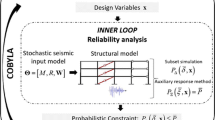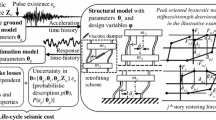Abstract
This paper presents an effective approach for achieving minimum cost designs for seismic retrofitting using viscous fluid dampers. A new and realistic retrofitting cost function is formulated and minimized subject to constraints on inter-story drifts at the peripheries of frame structures. The components of the new cost function are related to both the topology and to the sizes of the dampers. This constitutes an important step forward towards a realistic definition of the optimal retrofitting problem. The optimization problem is first posed and solved as a mixed-integer problem. To improve the efficiency of the solution scheme, the problem is then re-formulated and solved by nonlinear programming using only continuous variables. Material interpolation techniques, that have been successfully applied in topology optimization and in multi-material optimization, play a key role in achieving practical final design solutions with a reasonable computational effort. Promising results attained for 3-D irregular frames are presented and compared with those achieved using genetic algorithms.
















Similar content being viewed by others
References
Agrawal AK, Yang JN (1999) Optimal placement of passive dampers on seismic and wind-excited buildings using combinatorial optimization. J Intell Mater Syst Struct 10(12):997–1014
Aguirre JJ, Almazán JL, Paul CJ (2013) Optimal control of linear and nonlinear asymmetric structures by means of passive energy dampers. Earthq Eng Struct Dyn 42(3):377–395
Almazán JL, de la Llera JC (2009) Torsional balance as new design criterion for asymmetric structures with energy dissipation devices. Earthq Eng Struct Dyn 38(12):1421–1440
Avishur M, Lavan O (2010) Seismic behavior of passively controlled frames under structural uncertainties. In: Structures congress, Orlando, Florida
Bendsøe MP (1989) Optimal shape design as a material distribution problem. Struct Optim 1(4):193–202
Bendsøe MP, Sigmund O (2003) Topology optimization: theory, methods and applications. Springer, Berlin
Bigdeli K, Hare W, Nutini J, Tesfamariam S (2015) Optimizing damper connectors for adjacent buildings.arXiv preprint arXiv:1511.02182
Charmpis DC, Komodromos P, Phocas MC (2012) Optimized earthquake response of multi-storey buildings with seismic isolation at various elevations. Earthq Eng Struct Dyn 41(15):2289–2310
Cheney EW, Goldstein AA (1959) Newton’s method for convex programming and Tchebycheff approximation. Numer Math 1(1):253–268
Christopoulos C, Filiatrault A, Bertero VV (2006) Principles of passive supplemental damping and seismic lsolation. IUSS Press, Pavia
Civicioglu P (2013) Backtracking search optimization algorithm for numerical optimization problems. Appl Math Comput 219(15):8121–8144
Constantinou MC, Soong TT, Dargush GF (1998) Passive energy dissipation systems for structural design and retrofit. Multidisciplinary Center for Earthquake Engineering Research Buffalo, New York
Constantinou MC, Symans MD (1992) Experimental and analytical investigation of seismic response of structures with supplemental fluid viscous dampers. National Center for Earthquake Engineering Research, Taipei
Dargush GF, Sant RS (2005) Evolutionary aseismic design and retrofit of structures with passive energy dissipation. Earthq Eng Struct Dyn 34(13):1601–1626
Eschenauer HA, Olhoff N (2001) Topology optimization of continuum structures: a review. Appl Mech Rev 54(4):331–390
García M, de la Llera JC, Almazán JL (2007) Torsional balance of plan asymmetric structures with viscoelastic dampers. Eng Struct 29(6):914–932
Gidaris I, Taflanidis AA (2015) Performance assessment and optimization of fluid viscous dampers through life-cycle cost criteria and comparison to alternative design approaches. Bull Earthq Eng 13(4). doi:10.1007/s10518-014-9646-5
Goel RK (1998) Effects of supplemental viscous damping on seismic response of asymmetric-plan systems. Earthq Eng Struct Dyn 27(2):125–141
Goel RK (2000) Seismic behaviour of asymmetric buildings with supplemental damping. Earthq Eng Struct Dyn 29(4):461–480
Guest JK, Prévost JH, Belytschko T (2004) Achieving minimum length scale in topology optimization using nodal design variables and projection functions. Int J Numer Methods Eng 61(2):238–254
Hvejsel CF, Lund E (2011) Material interpolation schemes for unified topology and multi-material optimization. Struct Multidiscip Optim 43(6):811–825
Kanno Y (2013) Damper placement optimization in a shear building model with discrete design variables: a mixed-integer second-order cone programming approach. Earthq Eng Struct Dyn 42(11):1657–1676
Kelley JE Jr (1960) The cutting-plane method for solving convex programs. J Soc Ind Appl Math 8(4):703–712
Kim J, Bang S (2002) Optimum distribution of added viscoelastic dampers for mitigation of torsional responses of plan-wise asymmetric structures. Eng Struct 24(10):1257–1269
Lavan O (2012) On the efficiency of viscous dampers in reducing various seismic responses of wall structures. Earthq Eng Struct Dyn 41(12):1673–1692
Lavan O (2015) Optimal design of viscous dampers and their supporting memebers for the seismic retrofitting of 3D irregular frame structures. J Struct Eng
Lavan O, Amir O (2014) Simultaneous topology and sizing optimization of viscous dampers in seismic retrofitting of 3D irregular frame structures. Earthq Eng Struct Dyn 43:1325–1342
Lavan O, Dargush GF (2009) Multi-objective evolutionary seismic design with passive energy dissipation systems. J Earthq Eng 13(6):758–790
Lavan O, Levy R (2005) Optimal design of supplemental viscous dampers for irregular shear-frames in the presence of yielding. Earthq Eng Struct Dyn 34(8):889–907
Lavan O, Levy R (2006) Optimal peripheral drift control of 3D irregular framed structures using supplemental viscous dampers. J Earthq Eng 10(6):903–923
Lavan O, Levy R (2009) Simple iterative use of Lyapunov’s solution for the linear optimal seismic design of passive devices in framed buildings. J Earthq Eng 13(5):650–666
Levy R, Lavan O (2006) Fully stressed design of passive controllers in framed structures for seismic loadings. Struct Multidiscip Optim 32(6):485–498
Lin WH, Chopra AK (2001) Understanding and predicting effects of supplemental viscous damping on seismic response of asymmetric one-storey systems. Earthq Eng Struct Dyn 30(10):1475–1494
Lin WH, Chopra AK (2003a) Asymmetric one-storey elastic systems with non-linear viscous and viscoelastic dampers: earthquake response. Earthq Eng Struct Dyn 32(4):555–577
Lin WH, Chopra AK (2003b) Asymmetric one-storey elastic systems with non-linear viscous and viscoelastic dampers: simplified analysis and supplemental damping system design. Earthq Eng Struct Dyn 32(4):579–596
Lopez Garcia D, Soong TT (2002) Efficiency of a simple approach to damper allocation in MDOF structures. J Struct Control 9(1):19–30
Miguel LFF, Fadel Miguel LF, Lopez RH (2014) A firefly algorithm for the design of force and placement of friction dampers for control of man-induced vibrations in footbridges. Optim Eng 16(3):633–661
Miguel LFF, Miguel LFF, Lopez RH (2015) Simultaneous optimization of force and placement of friction dampers under seismic loading. Eng Optim 1. doi:10.1080/0305215X.2015.1025774
National Information Service for Earthquake Engineering - University of California, Berkeley. 10 pairs of horizontal ground motions for Los Angeles with a probability of exceedence of 10% in 50 years. http://nisee.berkeley.edu/data/strong_motion/sacsteel/motions/la10in50.zip
Pollini N, Lavan O, Amir O (2014) Towards realistic minimum-cost seismic retrofitting of 3D irregular frames using viscous dampers of a limited number of size groups. In: Proceedings of the second European conference on earthquake engineering and seismology, Istanbul, Turkey
Shin H, Singh M (2014) Minimum failure cost-based energy dissipation system designs for buildings in three seismic regions—part I: elements of failure cost analysis. Eng Struct 74:266–274
Shin H, Singh M (2014) Minimum failure cost-based energy dissipation system designs for buildings in three seismic regions—part II: application to viscous dampers. Eng Struct 74:275–282
Singh MP, Moreschi LM (2001) Optimal seismic response control with dampers. Earthq Eng Struct Dyn 30(4):553–572
Soong TT, Dargush GF (1997) Passive energy dissipation systems in structural engineering. Wiley, New York
Stolpe M, Svanberg K (2001) An alternative interpolation scheme for minimum compliance topology optimization. Struct Multidiscip Optim 22(2):116–124
Takewaki I (2011) Building control with passive dampers: optimal performance-based design for earthquakes. Wiley, New York
Takewaki I, Yoshitomi S, Uetani K, Tsuji M (1999) Non-monotonic optimal damper placement via steepest direction search. Earthq Eng Struct Dyn 28(6):655–670
Taylor D (2014) Personal comunication
Tso WK, Yao S (1994) Seismic load distribution in buildings with eccentric setback. Can J Civil Eng 21(1):50–62
Wu B, Ou JP, Soong TT (1997) Optimal placement of energy dissipation devices for three-dimensional structures. Eng Struct 19(2):113–125
Yang XS (2008) Nature-inspired metaheuristic algorithms, 1st edn. Luniver Press, London
Zhang RH, Soong TT (1992) Seismic design of viscoelastic dampers for structural applications. J Struct Eng 118(5):1375–1392
Acknowledgments
The authors are grateful to the anonymous reviewers for their helpful comments.
Author information
Authors and Affiliations
Corresponding author
Rights and permissions
About this article
Cite this article
Pollini, N., Lavan, O. & Amir, O. Towards realistic minimum-cost optimization of viscous fluid dampers for seismic retrofitting. Bull Earthquake Eng 14, 971–998 (2016). https://doi.org/10.1007/s10518-015-9844-9
Received:
Accepted:
Published:
Issue Date:
DOI: https://doi.org/10.1007/s10518-015-9844-9




